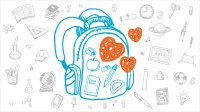Empathy: The Most Important Back-to-School Supply
My most important back-to-school supply doesn't fit in a backpack, and it can't be ordered online. It's as essential as a pencil, but unlike a pencil, no technology can replace it. In a sense, like a fresh box of crayons, it can come in many colors. Better than the latest gadget, it's possible to equip every student with it, and even better, when we do, it can transform our world.
It's actually a "muscle" I've been working on all summer. It's empathy.
What's the Big Deal About Empathy?
Empathy starts with putting yourself in someone else's shoes -- a key step in understanding perspectives that differ from your own. This isn't just a nice thing to do; it's an essential, active skill. It's foundational to embracing differences, building relationships, gaining a global perspective, conducting richer and deeper analysis, and communicating more effectively. This skill is about as "21st century" as it gets. And like a muscle, empathy gets stronger and stronger with practice and can be developed by any grade school child. This is the muscle that allows you to stand up for something, not just stand by.
Also like a muscle, empathy is easy to forget, particularly when operating in a crisis mode, always putting out fires. As a personal example, my daughter had a recent health scare -- we discovered she was "skinny-fat." Her small dress size belied physical weakness and a low endurance level. This scare drove home the point that what may pass as fit on the surface might be masking deeper problems.
As we think about empathy in a well-functioning classroom, the physical state can serve as a metaphor for the health of the social-emotional learning setting: A classroom might look fine on the surface, doing OK on standardized tests, memorizing facts and figures, but its internal environment might remain weak. Weakness in this case is manifested where children lack the more subtle tools that build 21st century learning and global competency. Absent empathy, sincere kindness and unity, how useful are passing test scores for changing communities and an ailing world?
It goes farther than that. An empathic environment is a smarter environment. According to Vicki Zakrzewski, education director at the Greater Good Science Center at UC Berkeley, "Scientific research is starting to show that there is a very strong relationship between social-emotional learning and cognitive development and performance." She adds, "Children as young as 18 months exhibit compassion, empathy, altruism, so these characteristics are part of who we are. But, at the same time, these skills have to be cultivated, because the environment can inhibit their development." In other words, empathy, like a physical muscle, is present -- but to manifest itself, it must be exercised.
A Fitness Plan for Building an Empathy Muscle
Back-to-school offers an ideal time to establish that your school or classroom prioritizes the active development of empathy -- that you'll take a stand for it.
A terrific starting point is offered by Ashoka, a nonprofit organization dedicated to encouraging social innovation around the world. Their Start Empathy initiative shares research, case studies and inspirational stories, and is building a network of Changemaker Schools committed to building empathic, encouraging environments at the elementary level. They've developed a road map for navigating a course to empathy -- suitable for any age. You might also consider it a three-step fitness plan to build the empathy muscle.
Step 1. Prepare
Create the conditions in which empathy can thrive.
- Create a Safe Space: A trust-based environment is core to unlocking empathy.
- Lead by Example: Consider what empathy looks like in your interactions, and model this.
- Develop Emotional Competency: Understand and manage your own emotions in order to identify and interpret these emotions in others.
Step 2. Engage
Take action that suits your personality and interests. There is no fixed course of engagement, but here are a few key activities.
- Group Play: Empathy begins on the playground, where imagination is allowed to run free, where kids learn to solve their own conflicts and enforce their own rules.
- Storytelling: Stories challenge our preconceptions, enabling us to wear the shoes of those whose experiences are different from our own.
- Immersion: By immersing ourselves in others' experiences, we learn to look beyond labels and stereotypes, and shift from projection to deep understanding.
- Problem Solving: The act of collaboration builds empathy through shared challenges and victories.
Step 3. Reflect & Act
Action and reflection complete the circle, and form a vital distinction between "teaching to the test" versus internalizing knowledge and making a difference with that learning.
- Identify Shared Values and Differences: As the Start Empathy road map explains, "Empathy means recognizing the shared humanity in others but also naming and appreciating differences. This is how we move from projection, where we imagine what we would do in someone else's shoes, to empathy, where we understand and respect the decisions of another."
- Instill Courage: Go beyond praising the right behaviors -- proactively counteract the forces that stand in their way. This is where standing up, not just standing by, comes in.
- Enable Action: Finally, create opportunities through which kids can put empathy into action and exercise pro-social behavior intended to benefit others.
This plan is summarized in a toolkit from Start Empathy. Download and print the poster to display prominently in your classroom, administrative office, cafeteria -- wherever a gentle reminder can help build the empathy muscle. Share it with families through newsletters, your school's website -- whatever channels you use to communicate with home. Multiple reinforcements and multiple outlets for action can start to shift a class or school culture toward empathy as a strength that's consciously practiced and cultivated, contributing to life-long health, inside and out.
